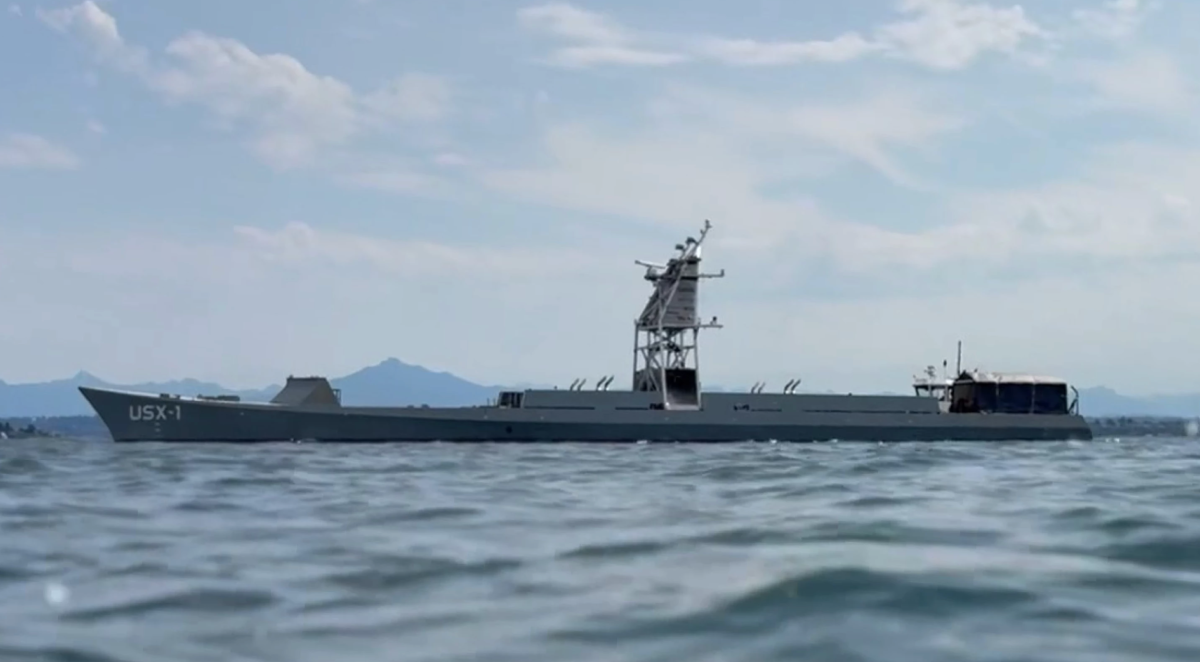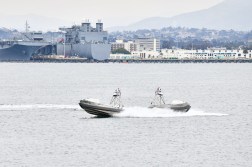DARPA christens USX-1 Defiant autonomous ship ahead of at-sea demonstrations

The Defense Advanced Research Projects Agency christened a new unmanned surface vessel Monday that the organization plans to transfer to the Navy following at-sea demonstrations.
The platform, known as the USX-1 Defiant, has a length of 180 feet, a height of 42 feet, a displacement of 529,000 pounds, and a top speed of 20 knots. It’s designed to survive 30-foot waves and operate autonomously at sea for up to a year, DARPA said.
The agency has tested an at-sea refueling capability that’s intended to be used with the Defiant.
The new USV was developed under the agency’s No Manning Required Ship, or NOMARS, program.
In a press release, the organization described the new system as a “first-of-its-kind autonomous, unmanned surface vessel designed from the ground up to never accommodate a human aboard,” featuring a simplified hull design “to allow rapid production and maintenance in nearly any port facility or Tier III shipyard that traditionally supports yacht, tug, and workboat customers.”
DARPA Director Stephen Winchell said the Defiant-class technology can “provide cost-effective, survivable, manufacturable, maintainable, long-range, autonomous, and distributed platforms, which will create future naval lethality, sensing, and logistics,” adding that it will “multiply combat power” and “unlock new American maritime industrial capacity.”
The agency released a short video of the vessel a few weeks ago.
Monday’s christening ceremony took place at Everett Ship Repair in Everett, Washington. Officials are in the process of completing final systems testing in preparation for an extended at-sea demonstration of reliability and endurance, according to the press release.
Once the at-sea demo is over, officials plan to deliver the robotic ship to the Navy’s Unmanned Maritime Systems Program Office (PMS 406).
“DARPA is working closely with the Navy to identify a pathway to ensure capabilities and technologies demonstrated throughout the NOMARS program are accessible for rapid transition and integration, are scalable, and support international defense partnerships,” the agency stated in the press release.
Navy officials are keen on integrating and scaling up the sea service’s arsenal of uncrewed surface vessels as they move to create a “hybrid fleet” of manned and unmanned platforms. Robotic systems are seen as a means of keeping sailors out of harm’s way and expanding warfighting capacity faster and cheaper than building traditional manned ships.
“The unique capabilities that unmanned systems bring to the naval and joint force are a tremendous force multiplier, and I believe the Department of the Navy should appropriately and adequately resource the right solutions and doctrine, organization, training, personnel and facilities that support these capabilities, particularly in the Indo-Pacific,” John Phelan, secretary of the Navy, wrote in response to advance policy questions from senators ahead of his confirmation hearing earlier this year.
“By providing persistent surveillance, intelligence gathering, defensive, and strike capabilities, unmanned systems will enhance lethality and serve as a strong and efficient deterrent to quickly respond to provocation while reducing risks and maintaining flexibility in the region,” Phelan added, noting that such technologies could help the United States prevail in a potential future conflict against a peer competitor such as China.
USVs were a key element of former Chief of Naval Operations Lisa Franchetti’s Project 33, an effort to accelerate the acquisition and fielding of unmanned systems, AI and “information dominance” capabilities to deter or defeat a Chinese attack on Taiwan or other U.S. interests in the Indo-Pacific.
“By 2027, we will integrate proven robotic and autonomous systems for routine use by the commanders who will employ them. We will integrate mature capabilities into all deploying Carrier and Expeditionary Strike Group certifications to refine our approach to command and control of manned-unmanned teams at sea,” she wrote in her CNO Navigation Plan.
President Donald Trump fired Franchetti in February without explanation.
However, Adm. Daryl Caudle, who was recently confirmed by the Senate to be the next chief of naval operations, has voiced support for integrating more unmanned technologies into the service. He told lawmakers that one of his top priorities for Navy transformation, if confirmed, would be to “accelerate delivery of integrated, networked capabilities across the joint force, including unmanned systems, artificial intelligence, and resilient C3 architectures to enable decision advantage and operational dominance in contested environments.”
Lawmakers have also been pushing for adding more USVs to the fleet. According to DARPA, Congress appropriated $2.1 billion for medium unmanned surface vessels in the reconciliation bill passed last month.
The Navy’s PMS 406 released a request for information last year on medium USVs, indicating that officials were interested in vessels less than 200 feet in length and under 500 tons displacement. The RFI noted that officials were “contemplating an accelerated approach with industry to leverage existing, manned or unmanned surface ship designs that can be modified to enable rapid delivery of an unmanned or optionally unmanned surface ship capability.”
The office was also slated to host an industry engagement in June about the Future USV program and the service’s vision, objectives, program schedule and technical requirements for a new robotic platform that can carry containerized payloads.






